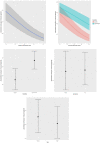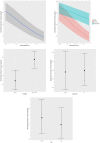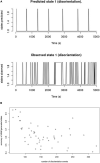Prediction of Disorientation by Accelerometric and Gait Features in Young and Older Adults Navigating in a Virtually Enriched Environment
- PMID: 35548510
- PMCID: PMC9083357
- DOI: 10.3389/fpsyg.2022.882446
Prediction of Disorientation by Accelerometric and Gait Features in Young and Older Adults Navigating in a Virtually Enriched Environment
Abstract
Objective: To determine whether gait and accelerometric features can predict disorientation events in young and older adults.
Methods: Cognitively healthy younger (18-40 years, n = 25) and older (60-85 years, n = 28) participants navigated on a treadmill through a virtual representation of the city of Rostock featured within the Gait Real-Time Analysis Interactive Lab (GRAIL) system. We conducted Bayesian Poisson regression to determine the association of navigation performance with domain-specific cognitive functions. We determined associations of gait and accelerometric features with disorientation events in real-time data using Bayesian generalized mixed effect models. The accuracy of gait and accelerometric features to predict disorientation events was determined using cross-validated support vector machines (SVM) and Hidden Markov models (HMM).
Results: Bayesian analysis revealed strong evidence for the effect of gait and accelerometric features on disorientation. The evidence supported a relationship between executive functions but not visuospatial abilities and perspective taking with navigation performance. Despite these effects, the cross-validated percentage of correctly assigned instances of disorientation was only 72% in the SVM and 63% in the HMM analysis using gait and accelerometric features as predictors.
Conclusion: Disorientation is reflected in spatiotemporal gait features and the accelerometric signal as a potentially more easily accessible surrogate for gait features. At the same time, such measurements probably need to be enriched with other parameters to be sufficiently accurate for individual prediction of disorientation events.
Keywords: actimetry; aging; executive function; gait; navigation; virtual reality; visuo-spatial abilities.
Copyright © 2022 Teipel, Amaefule, Lüdtke, Görß, Faraza, Bruhn and Kirste.
Conflict of interest statement
ST participated in scientific advisory boards of Roche Pharma AG, Biogen, GRIFOLS, EISAI, and MSD and received lecture fees from Roche and MSD. The remaining authors declare that the research was conducted in the absence of any commercial or financial relationships that could be construed as a potential conflict of interest.
Figures





Similar articles
-
Effect of Spatial Disorientation in a Virtual Environment on Gait and Vital Features in Patients with Dementia: Pilot Single-Blind Randomized Control Trial.JMIR Serious Games. 2020 Oct 8;8(4):e18455. doi: 10.2196/18455. JMIR Serious Games. 2020. PMID: 33030436 Free PMC article.
-
At Crossroads in a Virtual City: Effect of Spatial Disorientation on Gait Variability and Psychophysiological Response among Healthy Older Adults.Gerontology. 2023;69(4):450-463. doi: 10.1159/000527503. Epub 2022 Dec 5. Gerontology. 2023. PMID: 36470232 Free PMC article.
-
Real-Time Detection of Spatial Disorientation in Persons with Mild Cognitive Impairment and Dementia.Gerontology. 2020;66(1):85-94. doi: 10.1159/000500971. Epub 2019 Jul 30. Gerontology. 2020. PMID: 31362286
-
Performance in complex life situations: effects of age, cognition, and walking speed in virtual versus real life environments.J Neuroeng Rehabil. 2021 Feb 8;18(1):30. doi: 10.1186/s12984-021-00830-6. J Neuroeng Rehabil. 2021. PMID: 33557894 Free PMC article.
-
Neural correlates of spatial navigation changes in mild cognitive impairment and Alzheimer's disease.Front Behav Neurosci. 2014 Mar 17;8:89. doi: 10.3389/fnbeh.2014.00089. eCollection 2014. Front Behav Neurosci. 2014. PMID: 24672452 Free PMC article. Review.
References
-
- Albert M. S., Dekosky S. T., Dickson D., Dubois B., Feldman H. H., Fox N. C., et al. (2011). The diagnosis of mild cognitive impairment due to Alzheimer’s disease: recommendations from the National Institute on Aging-Alzheimer’s Association workgroups on diagnostic guidelines for Alzheimer’s disease. Alzheimers Dement. 7 270–279. 10.1016/j.jalz.2011.03.008 - DOI - PMC - PubMed
LinkOut - more resources
Full Text Sources
Miscellaneous

